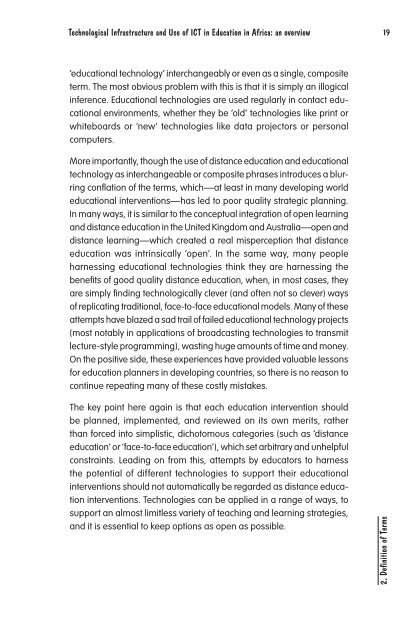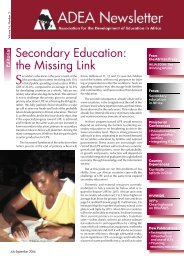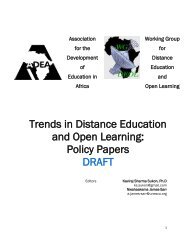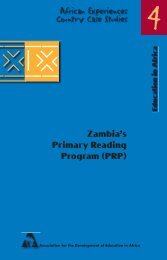Technological Infrastructure and Use of ICT in Education in ... - ADEA
Technological Infrastructure and Use of ICT in Education in ... - ADEA
Technological Infrastructure and Use of ICT in Education in ... - ADEA
Create successful ePaper yourself
Turn your PDF publications into a flip-book with our unique Google optimized e-Paper software.
<strong>Technological</strong> <strong>Infrastructure</strong> <strong>and</strong> <strong>Use</strong> <strong>of</strong> <strong>ICT</strong> <strong>in</strong> <strong>Education</strong> <strong>in</strong> Africa: an overview<br />
19<br />
‘educational technology’ <strong>in</strong>terchangeably or even as a s<strong>in</strong>gle, composite<br />
term. The most obvious problem with this is that it is simply an illogical<br />
<strong>in</strong>ference. <strong>Education</strong>al technologies are used regularly <strong>in</strong> contact educational<br />
environments, whether they be ‘old’ technologies like pr<strong>in</strong>t or<br />
whiteboards or ‘new’ technologies like data projectors or personal<br />
computers.<br />
More importantly, though the use <strong>of</strong> distance education <strong>and</strong> educational<br />
technology as <strong>in</strong>terchangeable or composite phrases <strong>in</strong>troduces a blurr<strong>in</strong>g<br />
conflation <strong>of</strong> the terms, which—at least <strong>in</strong> many develop<strong>in</strong>g world<br />
educational <strong>in</strong>terventions—has led to poor quality strategic plann<strong>in</strong>g.<br />
In many ways, it is similar to the conceptual <strong>in</strong>tegration <strong>of</strong> open learn<strong>in</strong>g<br />
<strong>and</strong> distance education <strong>in</strong> the United K<strong>in</strong>gdom <strong>and</strong> Australia—open <strong>and</strong><br />
distance learn<strong>in</strong>g—which created a real misperception that distance<br />
education was <strong>in</strong>tr<strong>in</strong>sically ‘open’. In the same way, many people<br />
harness<strong>in</strong>g educational technologies th<strong>in</strong>k they are harness<strong>in</strong>g the<br />
benefits <strong>of</strong> good quality distance education, when, <strong>in</strong> most cases, they<br />
are simply f<strong>in</strong>d<strong>in</strong>g technologically clever (<strong>and</strong> <strong>of</strong>ten not so clever) ways<br />
<strong>of</strong> replicat<strong>in</strong>g traditional, face-to-face educational models. Many <strong>of</strong> these<br />
attempts have blazed a sad trail <strong>of</strong> failed educational technology projects<br />
(most notably <strong>in</strong> applications <strong>of</strong> broadcast<strong>in</strong>g technologies to transmit<br />
lecture-style programm<strong>in</strong>g), wast<strong>in</strong>g huge amounts <strong>of</strong> time <strong>and</strong> money.<br />
On the positive side, these experiences have provided valuable lessons<br />
for education planners <strong>in</strong> develop<strong>in</strong>g countries, so there is no reason to<br />
cont<strong>in</strong>ue repeat<strong>in</strong>g many <strong>of</strong> these costly mistakes.<br />
The key po<strong>in</strong>t here aga<strong>in</strong> is that each education <strong>in</strong>tervention should<br />
be planned, implemented, <strong>and</strong> reviewed on its own merits, rather<br />
than forced <strong>in</strong>to simplistic, dichotomous categories (such as ‘distance<br />
education’ or ‘face-to-face education’), which set arbitrary <strong>and</strong> unhelpful<br />
constra<strong>in</strong>ts. Lead<strong>in</strong>g on from this, attempts by educators to harness<br />
the potential <strong>of</strong> different technologies to support their educational<br />
<strong>in</strong>terventions should not automatically be regarded as distance education<br />
<strong>in</strong>terventions. Technologies can be applied <strong>in</strong> a range <strong>of</strong> ways, to<br />
support an almost limitless variety <strong>of</strong> teach<strong>in</strong>g <strong>and</strong> learn<strong>in</strong>g strategies,<br />
<strong>and</strong> it is essential to keep options as open as possible.<br />
2. Def<strong>in</strong>ition <strong>of</strong> Terms

















